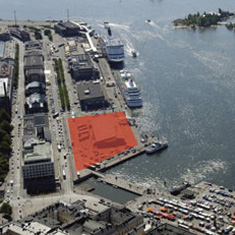The results of a study carried out by the Solomon R. Guggenheim Foundation on behalf of the City of Helsinki has revealed that it would be feasible to construct a new Guggenheim Museum in Finland.
The report proposes that the museum would be built on the waterfront and would have a stong focus on architecture and design, as well as art.
We announced the news of the report's commission this time last year - see our previous Dezeen Wire.
Read the full press release here:
City of Helsinki Receives Study For Potential Guggenheim Museum
A new Guggenheim museum in Helsinki would make a distinct contribution to Finland’s cultural landscape, according to the concept and development study that representatives of the Solomon R. Guggenheim Foundation presented January 10 to Helsinki Mayor Jussi Pajunen. The study was commissioned by the City of Helsinki a year ago to explore the possibility of creating a Guggenheim museum in Helsinki.
No decisions have been made regarding the proposal set forth in the study. The City Board and the City Council of Helsinki will review the recommendations in a public process that will extend at least into February 2012. The City of Helsinki will then decide whether to move to the next phase of the project. At that time, the Guggenheim Foundation Board of Trustees, in consultation with representatives of the Guggenheim Museum Bilbao, will also formally decide whether to endorse moving ahead.
The report by the Guggenheim study team proposes that a museum would be built on a city-owned site along the South Harbor waterfront, where the Kanava Terminal Building currently stands. The total area of the museum would be approximately 12,000 square meters (129,000 square feet), with 3,920 square meters (42,000 square feet) devoted to exhibition galleries.
The estimated construction costs of the building and its design would be approximately €140 million. The midrange estimated annual attendance of the proposed museum is 500,000–550,000 visits, of which approximately 300,000 would be by Finnish residents.
The study finds that the mission, international exhibitions, and programs of a new museum would not likely overlap with those of existing Helsinki institutions. Moreover, a new museum would give the city a signature space that symbolizes Helsinki’s aspirations to be a cultural capital. According to the study, a museum would powerfully contribute to the Finnish arts community by acting as an artistic center that convenes and collaborates with Helsinki’s other institutions and that draws greater global attention to Helsinki’s cultural contributions.
The new institution would help contextualize Finnish art, design, and architecture within the broader tradition of modern art while presenting Finnish audiences with artworks from around the world. It would have a stronger focus on architecture and design than other Guggenheim affiliates. As the newest affiliate, Helsinki would also be able to play a vital role in testing new approaches and technologies that could eventually benefit other members of the global network (and museums around the world) through Finland’s uniquely advanced technological networks and highly educated population.
Moreover, a new museum would be likely to increase cultural tourism and so would have the potential to increase overall attendance at other Helsinki arts institutions.
If all parties accept the study’s recommendations and resolve to move ahead, an international competition would be organized to select an architect for the new museum.
“Helsinki now has an incredible possibility that we should embrace,” stated Jussi Pajunen, the Mayor of Helsinki. “As the study shows, a Guggenheim museum would be a distinct place in Finland´s cultural landscape.”

